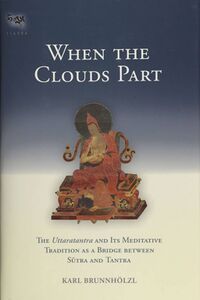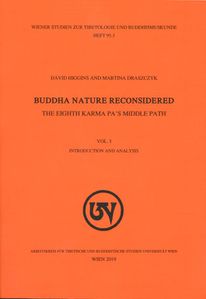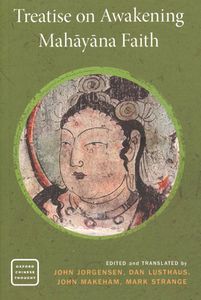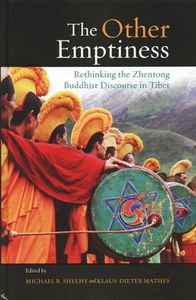Difference between revisions of "Explore"
((by SublimeText.Mediawiker)) |
((by SublimeText.Mediawiker)) |
||
| Line 426: | Line 426: | ||
</div> | </div> | ||
</div> | </div> | ||
| − | <div class="row m-0"> | + | <div class="row m-0 alex-gradient"> |
<div class="col-lg-9 p-0"> | <div class="col-lg-9 p-0"> | ||
{{FeaturedItem | {{FeaturedItem | ||
| Line 432: | Line 432: | ||
|title=On the Ratnagotravibhāga | |title=On the Ratnagotravibhāga | ||
|image=https://commons.tsadra.org/images-commons/5/50/Alexander_Gardner.jpg | |image=https://commons.tsadra.org/images-commons/5/50/Alexander_Gardner.jpg | ||
| − | |textclasses= | + | |textclasses= pt-3 pb-2 |
}} | }} | ||
</div> | </div> | ||
Revision as of 16:05, 16 July 2020
 Increased attention to the tathāgatagarbha doctrine in the last decade has lead to significant publications and meetings on the topic of buddha-nature and related themes. Scholars in Asia, Europe, and the Americas have published new translations and studies of the foundational scriptures and commentaries, and are examining the history and literature of the doctrine. In July 2019 Tsadra Foundation partnered with the University of Vienna to bring many of these scholars together for an international symposium titled Tathāgatagarbha Across Asia.
Increased attention to the tathāgatagarbha doctrine in the last decade has lead to significant publications and meetings on the topic of buddha-nature and related themes. Scholars in Asia, Europe, and the Americas have published new translations and studies of the foundational scriptures and commentaries, and are examining the history and literature of the doctrine. In July 2019 Tsadra Foundation partnered with the University of Vienna to bring many of these scholars together for an international symposium titled Tathāgatagarbha Across Asia. See all presentations
Klaus-Dieter Mathes
Ngawang Jorden
Jacqueline Stone
Ringu Tulku
Tokpa Tulku
I.28
རྫོགས་སངས་སྐུ་ནི་འཕྲོ་ཕྱིར་དང་། །
དེ་བཞིན་ཉིད་དབྱེར་མེད་ཕྱིར་དང་། །
རིགས་ཡོད་ཕྱིར་ན་ལུས་ཅན་ཀུན། །
རྟག་ཏུ་སངས་རྒྱས་སྙིང་པོ་ཅན། །
Since the perfect buddhakaya radiates,
Since suchness is undifferentiable,
And because of the disposition,
All beings always possess the buddha heart.
संबुद्धकायस्फरणात् तथताव्यतिभेदतः
गोत्रतश्च सदा सर्वे बुद्धगर्भाः शरीरिणः
佛法身遍滿 真如無差別
皆實有佛性 是故說常有
Now, with regard to suchness with stains, it is said that "all sentient beings possess the tathāgata heart."[1] {P90b} By virtue of which purport is that [said]? {J26}
Since buddha wisdom enters into the multitudes of beings,
Since its stainlessness is nondual by nature,
And since the buddha disposition is metaphorically referred to by
[the name of] its fruition,
All beings are said to possess the buddha [heart].[2] I.27
Since the perfect buddhakāya radiates,
Since suchness is undifferentiable,
And because of the disposition,
All beings always possess the buddha heart. I.28
In brief, it is in a threefold sense that the Bhagavān spoke of "all sentient beings always possessing the tathāgata heart."[3] {D88b} That is, [he spoke of this] in the sense that the dharmakāya of the Tathāgata radiates in [or into] all sentient beings, in the sense that the suchness of the Tathāgata is undifferentiable [from the suchness of beings], and in the sense that the tathāgata disposition really exists[4] [in these beings].[5] These three topical points will be taught [in detail] below [through nine examples] according to the Tathāgatagarbhasūtra.[6] Prior to that, however, the topic [consisting of these three points] is pointed out in all its aspects in the sense in which it is invariably taught in all the words [of the Buddha].[7] It is based on this that I shall discuss it [now, beginning with] a synopsis.[8]
- The wordings identical or similar to the phrase "all sentient beings possess the tathāgata heart" (also found in the text below right after I.133) or "all sentient beings always possess the tathāgata heart" (see the text below right after I.28) in RGVV occur several times in the Tathāgatagarbhasūtra. As RGVV says just below in the text (following I.28), it is precisely according to that sūtra that the three meanings of this phrase will be explained.
- In the Tibetan editions of the Uttaratantra, this verse follows I.28, and some editions omit it altogether. JKC (50) notes this fact and says that it does belong to the text since Dölpopa, Karma Könshön (a student of the Third Karmapa), Rongtön, Gö Lotsāwa, and others quote and comment on it extensively.
- DP and C reverse the order of verses I.27–28 and insert this sentence between them. For the sake of conforming with the pattern of the respective initial two verses on each one of the three jewels in the text above and the following topics below, Takasaki suggests to insert "What is taught by this?" (anena kiṃ darśitam /) between these two verses.
- This follows Schmithausen’s suggestion of sadbhāvārthena for saṃbhāvārthena. Schmithausen points out that the virtually identical term gotrasadbhāvārtham appears in the text below (J72.8; see the comments on I.149ff.).
- There are many volumes in Tibet as well as by Japanese and Western scholars on how Uttaratantra I.28 in general and its compound buddhagarbhāḥ in particular can be interpreted, so I will highlight just a few points here. As for the somewhat differing Sanskrit and Tibetan versions, spharaṇa in I.28a literally means "quivering," "throbbing," "vibrating," or "penetrating" (the Tibetan here is ’phro ba but khyab pa in the text below in the comments on I.146). Also, Uttaratantra II.13, II.93, and IV.61 use spharaṇa in connection with light rays, and the version of I.28a in Ratnākaraśānti’s Sūtrasamuccayabhāṣya (D3935, fol. 297a.1) says "the illuminating dharmadhātu radiates" (chos dbyings snang byed ’od ’byung). SM 8b "since the welfare of sentient beings depends on the victor,"which is a reformulation of Uttaratantra I.27a and I.28a, suggests an interaction between the dharmakāya of a buddha and the buddha natures of sentient beings. In this vein, an interlinear gloss on verse 11 explicitly relates the twofold dharmakāya—"the utterly stainless dharmadhātu and its natural outflow (teaching the principles of profundity and diversity)"in Uttaratantra I.145 (explained by RGVV as "consisting of the arising of [individually] corresponding [forms of] cognizance in other sentient beings to be guided")—to "the perfect buddhakāya radiates."Compare also the even more explicit explanation on such an interaction between the dharmakāya of a buddha and the tathāgata hearts of beings in CMW on I.28a (473), which says the following. In order to purify the basic element of sentient beings, with the dharmakāya functioning as the support, the sambhogakāya and the nirmāṇakāya perform the welfare of beings through pervading pure and impure retinues, respectively. Therefore, the basis to be purified—the tathāgata heart—exists in all sentient beings. For, if this basis to be purified did not exist in them, their being pervaded by the activity of the three kāyas would be pointless. CMW (480) also says that even those with wrong craving thrive through virtue (the cause for meeting a buddha in the future) because they have the naturally pure disposition. Without this naturally pure disposition, they would not thrive through the light rays of the wisdom of the tathāgatas and virtue. Similarly, YDC (374) answers some objections to enlightened activity by explaining it as the interaction between the dharmakāya of a buddha and the basic element of sentient beings: "‘There is no object for the enlightened activity of awakening to engage because sentient beings are by nature afflicted, similar to the activity of digging for gold’s not engaging anything if there is no gold.’ This is not true—since awakening exists in sentient beings too without any difference, it is that in which enlightened activity engages. ‘But if awakening exists in them without difference, enlightened activity does not need to engage it.’ Since it is obscured by adventitious afflictions, just as the sky is by clouds, these must be dispelled. ‘Enlightened activity does not have the power to do so.’ It does have that power because it entails great compassion." In addition, compare Padma Karpo’s explanation of I.28a in appendix 1. See also Ruegg (1969, 273) and Ruegg (1973, 97), who translates spharaṇa in I.28a as "irradiation." For these reasons, I chose "radiating"for spharaṇa since that English word covers both the meaning of "penetrating" and the sense of the tathāgata heart’s being vibrant with the energy of its natural luminosity (see the example below in this note of violins vibrating). As for vyatibheda in I.28b, rendered as "undifferentiable"above in the text (which corresponds more to Tib. dbyer med), it literally means "pervading." In the Tibetan, I.28c says "because the disposition exists (yod)," and I.28d ends in can, which literally means "to possess." However, can is also a common way to indicate a bahuvrīhi compound in Tibetan translations from Sanskrit, as is the case here. The two most basic renderings of the Sanskrit of the fourth line with its compound buddhagarbhāḥ are "all beings are always such that they contain a buddha/have a buddha as their core." Interestingly, in the early Tibetan translations, this line ended in yin ("are"), which was only replaced by can at a rather late point. The most obvious reason for this is to avoid the reading "all beings are the buddha heart,"which is immediately suggested to readers of Tibetan unfamiliar with the underlying Sanskrit. Though I use the word "possess" in I.28d, it is not meant in the sense of sentient beings’ actually owning buddha nature. Nevertheless, especially some later Tibetan (and Western) commentators greatly emphasize that beings actually possess the buddha heart or even full-fledged buddhahood. This is denied at length by the Eighth Karmapa’s commentary on the Abhisamayālaṃkāra (see Brunnhölzl 2010, 438–43). It is also contradicted by Uttaratantra I.27, which explicitly says that the disposition is not the actual buddhahood or dharmakāya—the fruition—but a case of labeling the cause with the name of its result. So, one way to look at these two verses is in terms of cause, fruition, and their fundamental equality. In this way, the disposition is the cause for the fruition of the buddhakāya, with suchness indicating that this "cause" is not different from the result (the nature of the mind being always the same in sentient beings and buddhas, or, throughout ground, path, and fruition). This is underlined by Uttaratantra I.142ab:
Its nature is buddhakāya,
Suchness, and the disposition.- As the Eighth Karmapa demonstrates in detail, it is impossible to establish verses I.27– 28 as strict logical proofs for buddha nature’s actually existing in all beings or their possessing it (these verses may only serve as indications or metaphors from the perspective of convenient parlance). This is also highlighted by the fact that in the Tibetan tradition, buddha nature is typically considered as a "very hidden phenomenon," which by definition does not lie within the reach of inferential valid cognition, but can be approached only through valid Buddhist scriptures. For a selection of Indian and Tibetan that offer more affirmative explanations of the three "proofs"in Uttaratantra I.27–28, see appendix 1.
- Without going into further details, I would like to present another more path-oriented example that adds to the perspective on the three "proofs,"especially "the buddhakāya radiating." As we saw, the first lines in the three verses I.27, I.28, and I.142 of the Uttaratantra equate buddhakāya, buddha wisdom, and dharmakāya, respectively, clearly indicating that the dharmakāya is not just mere emptiness but—as buddha wisdom—it actively engages and communicates with sentient beings. This is also clearly suggested by Uttaratantra I.145, which describes the dharmakāya as twofold: (a) the completely unstained dharmadhātu and (b) its natural outflow that consists of the teachings of the principles of profundity and diversity—which is used by SM as a gloss of the first line of I.28. RGVV explains that the dharmakāya of buddhas consists not only of (a), which is the dharma that represents the sphere of nonconceptual wisdom and is to be personally experienced by these buddhas. The natural outflow of the pure dharmadhātu (b), which is the cause for attaining (a), consists of the arising of individually corresponding forms of cognizance in the beings to be guided, which is the dharma that is the teaching. This fits with the explanation of line I.28a in the Eighth Karmapa’s Lamp (14–15): "At the point when the wisdom of realization—the awareness that exists primordially as not being different from the sugata heart as the expanse—rises from the expanse that is the profound matrix of the sugata heart, all seeds of obscuration are relinquished. The self-awareness of this wisdom of realization is accomplished through the wisdom of the fundamental change of [having gathered] immeasurable accumulations [of merit and wisdom]. You may wonder, ‘How is it accomplished?’ The cognition that frees from stains [and exists] in the cognizance of sentient beings that is associated with obscurations is blessed by the inconceivable power of the wisdom [of a buddha]. In addition, there [also] exists the element of wisdom in the element that is the cognition [of sentient beings] free from stains. It is by virtue of the power of both [the cognition that frees from stains and is blessed by buddha wisdom and the intrinsic wisdom of sentient beings] that their cognizance fundamentally changes into being without stains, and thus the wisdom of realization becomes of one taste with the dharmakāya."Later, the Lamp (30–31) says: "That certain [beings] to be guided see these miracles of the body, speech, and mind of the [buddhas] is by virtue of the power of both the tathāgatas’ compassion of blessing, emanating, and transforming adventitious seeming [reality] through their having gained mastery over powerful ultimate reality and the tathāgata hearts of those to be guided, whose mind streams are endowed with the tathāgata heart. [Through this,] even ordinary beings are able to realize the miracles of the bhagavāns, the indestructible vajra points." In addition, as mentioned above, the Sanskrit term spharaṇa for "radiates"literally means "vibrates." So, as far as the "awakening"of buddha nature in sentient beings is concerned, one may think of both buddhas and sentient beings as violins, with the "buddha violins"being in perfect tune and playing loudly, clearly, and all the time (teaching the dharma in various ways), while the strings of the "sentient being violins"are covered by a very light cloth. In that situation, the strings of the latter violins will not resound when the former play, but all the strings with the same tuning will at least start to vibrate, even if they are covered by such a light cloth. The less they are covered and the louder the strings of the "buddha violins"play, the stronger they will vibrate, so that the cloth starts moving and gradually slips off the strings, resulting in the strings of the "sentient being violins"gradually resounding louder and clearer too. Likewise, on the path, the more the qualities of buddha nature in beings are stimulated and thus "shake off,"so to speak, their adventitious obscurations, the more these qualities manifest fully. In brief, the first line of Uttaratantra I.28 refers to the "buddha violins"vibrating and the third line to the "sentient being violins." The fact that the former can actually make the latter vibrate too is shown by the second line, which states (in effect) that their "strings"are indeed of the same nature. For further discussions of Uttaratantra I.27–28, see appendix 1 as well as Ruegg 1969, 272–86, Mipham Rinpoche’s Lamp of Certainty (Pettit 1999, 384–87), and Kano 2006.
- RGVV provides an explanation of I.27–28 in the context of matching the nine examples for buddha nature with its threefold nature of dharmakāya, suchness, and the disposition (see I.143–52).
- DP have this sentence in a slightly different form ("This topic in all its aspects should be explained through the sense in which it is invariably taught in all the words [of the Buddha]") immediately after verse I.27 and preceding the above sentence "That is, [he spoke of this] in the sense . . ." As for "the sense in which it is invariably taught in all the words [of the Buddha],"it seems difficult to ascertain that buddha nature is always explained by way of the following ten topics in the scriptures. However, as mentioned in the introduction, the first six seem to be a rather common template, at least in Yogācāra texts, in particular in their descriptions of ultimate reality, and RGVV (J40) says at the end of the sixth topic that the remaining four topics are simply extensions of the sixth one. GC (330) also states that this template of six topics is found in many texts besides the Uttaratantra (such as the Abhidharmasamuccaya) and explains that the first topic "nature" is the main point to be understood, while the remaining five topics represent the means to understand this first topic. In addition, the Uttaratantra also uses the very same six topics in its second chapter to describe awakening, with the seventh and eighth topics in this chapter being again extensions of the sixth one.
- Due to the above-mentioned differences in PD, the section after "By virtue of which purport is that [said]?"reads: "I.28. In brief, it is in a threefold sense that the Bhagavān spoke of ‘all sentient beings always possessing the tathāgata heart.’ I.27. This topic in all its aspects should be explained through the sense in which it is invariably taught in all the words [of the Buddha]. It is based on this that I shall discuss it [here]. That is, [he spoke of this] in the sense that the dharmakāya of the Tathāgata radiates in [or into] all sentient beings, in the sense that the suchness of the Tathāgata is undifferentiated [from the suchness of beings], and in the sense that the tathāgata disposition exists [in these beings]. These three topical points will be taught [in detail] below according to the Tathāgatagarbhasūtra. [Here, I begin with] a synopsis."GC (263.6–7 and 22–25) reads: "I.27. This topic in all its aspects is pointed out through the sense in which it is invariably taught in all the words [of the Buddha]. It is based on this that I shall discuss it first. I.28. In brief, it is in a threefold sense that the Bhagavān spoke of ‘all sentient beings always possessing the tathāgata heart.’ That is, [he spoke of this] in the sense that the dharmakāya of the Tathāgata radiates in [or into] all sentient beings, in the sense that the suchness of the Tathāgata is undifferentiated [from the suchness of beings], and in the sense that the tathāgata disposition really exists [in these beings]. These three topical points will be taught [in detail] below according to the Tathāgatagarbhasūtra. [Here, I begin with] a synopsis."
tatra samalāṃ tathatāmadhikṛtya yaduktaṃ sarvasattvāstathāgatagarbhā iti tat kenārthena/
buddhajñānāntargamāt sattvarāśe-
stannairmalyasyādvayatvāt prakṛtyā/
bauddhe gotre tatphalasyopacārā-
duktāḥ sarve dehino buddhagarbhāḥ//27//
saṃbuddhakāyaspharaṇāt tathatāvyatibhedataḥ/
gotrataśca sadā sarve buddhagarbhāḥ śarīriṇaḥ//28//
samāsatastrividhenārthena sadā sarvasattvāstathāgatagarbhā ityuktaṃ bhagavatā/ yaduta sarvasattveṣu tathāgatadharmakāyaparispharaṇārthena tathāgatatathatāvyatibhedārthena tathāgatagotrasaṃbhavārthena ca/ eṣāṃ punastrayāṇāmarthapadānāmutaratra tathāgatagarbhasūtrānusāreṇa nirdeśo bhaviṣyati/ pūrvataraṃ tu yenārthena sarvatrāviśeṣeṇa pravacane sarvākāraṃ tadarthasūcanaṃ bhavati tadapyādhikṛtya nirdekṣyāmi/
論曰自此已後餘殘論偈次第依彼四句廣差別說應知此以何義向前偈言
真如有雜垢 及遠離諸垢 佛無量功德 及佛所作業 如是妙境界 是諸佛所知 依此妙法身 出生於三寶 此偈示現何義如向所說一切眾生有如來藏彼依何義故如是說偈言
佛法身遍滿 真如無差別 皆實有佛性 是故說常有
一切眾生界 不離諸佛智 以彼淨無垢 性體不二故 依一切諸佛 平等法性身 知一切眾生 皆有如來藏
Click to view all verses




